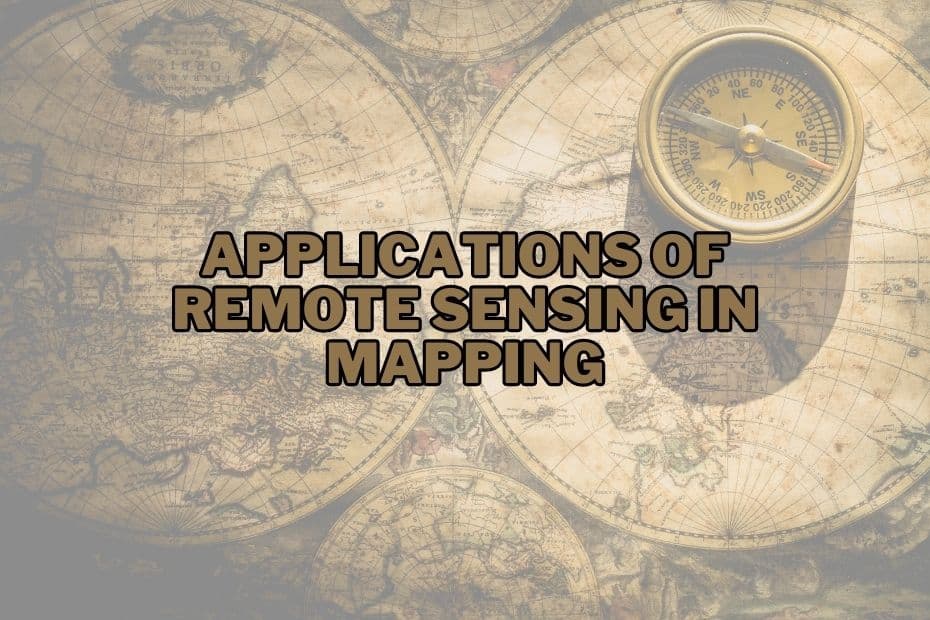From monitoring land cover changes to tracking urban growth, remote sensing has become an indispensable tool for scientists, researchers, and decision-makers alike. As we delve into the fascinating application of remote sensing in mapping, we uncover a dozen ways this remarkable technology is transforming our understanding of Earth’s dynamic landscapes and aiding in informed decision-making for a sustainable future.
Remote sensing plays a pivotal role in mapping by utilizing satellite and aerial data to capture information about Earth’s surface. It aids in environmental monitoring, urban planning, agriculture, and disaster management. This technology enables precise spatial analysis, allowing for efficient resource management and informed decision-making.
Role of Remote Sensing in Cartography
Remote sensing has significantly advanced the field of cartography by providing accurate, up-to-date, and detailed data that contribute to the creation of comprehensive maps. It utilizes various sensors mounted on satellites, aircraft, or ground-based platforms to capture data in the form of imagery, which is then processed and analyzed to generate maps.
This technology enables cartographers to produce maps that encompass geological features, disease distribution, topographical variations, soil types, land use patterns, urban development, environmental changes, vegetation distribution, disaster-prone areas, archaeological sites, and even subsurface structures.
Application of Remote Sensing In Mapping
Remote sensing, a technology that enables the collection of information about the Earth’s surface without physical contact, has revolutionized the field of cartography. let’s delves into the myriad application of remote sensing in mapping diverse features of our planet.
1. Geological and Mineral Mapping
Remote sensing has emerged as a powerful tool for geological and mineral mapping. By analyzing satellite imagery and data, geologists can identify different rock types, mineral deposits, and geological structures on the Earth’s surface. This aids in resource exploration, mineral prospecting, and environmental impact assessments in mining activities.
2. Disease Mapping
The application of remote sensing in disease mapping has transformed public health strategies. By monitoring environmental factors, such as temperature, humidity, and land cover changes, health organizations can predict disease outbreaks, track their spread, and deploy resources effectively to mitigate their impact.
3. Topographical Mapping
Topographical mapping involves the creation of detailed representations of the Earth’s surface, showcasing variations in elevation. Remote sensing technologies, such as LiDAR (Light Detection and Ranging), provide high-resolution elevation data that contribute to accurate topographical maps. These maps play a crucial role in urban planning, infrastructure development, and disaster preparedness.
4. Soil and Land Mapping
Mapping soil types and land use patterns are essential for agriculture, forestry, and environmental management. Remote sensing enables the assessment of soil properties and the classification of land cover, aiding in land suitability analysis, crop monitoring, and land degradation assessment.
5. Urban Planning and Development
Remote sensing assists urban planners in understanding the dynamics of urban areas. It provides data on population density, land use changes, infrastructure development, and traffic patterns, helping authorities make informed decisions for sustainable urban growth.
6. Environmental Mapping Applications
Remote sensing is pivotal in monitoring environmental changes, including deforestation, pollution, and habitat loss. By capturing satellite images over time, researchers can quantify these changes, leading to better conservation strategies.
7. Vegetation Monitoring
Monitoring vegetation health and distribution is crucial for biodiversity conservation and ecosystem management. Remote sensing techniques allow researchers to analyze the vigor of vegetation, detect stressors, and assess the impact of climate change on ecosystems.
8. Disaster Management and Mitigation
Remote sensing plays a vital role in disaster management by providing rapid and accurate information during emergencies. It aids in assessing the extent of damage caused by natural disasters such as earthquakes, floods, and cyclones, enabling effective response and recovery efforts.
9. Archaeological Site Mapping
Archaeologists utilize remote sensing to uncover hidden archaeological sites. Satellite imagery and aerial photography can reveal subtle variations in the landscape, indicating potential archaeological features buried beneath the surface.
10. Subsurface Mapping
Remote sensing is also valuable for subsurface mapping, particularly in the oil and gas industry. Seismic surveys and ground-penetrating radar use remote sensing principles to analyze subsurface structures and locate valuable resources.
Conclusion:
In conclusion, the applications of remote sensing in mapping are incredibly diverse and influential across various fields. From geological and mineral mapping to disaster management and beyond, this technology enhances our understanding of the Earth’s features and empowers decision-making processes for a sustainable future.
FAQs: Application of Remote Sensing In Mapping
How does remote sensing contribute to disease mapping?
Remote sensing helps track environmental factors that influence disease spread, enabling timely interventions and resource allocation.
What is LiDAR, and how does it aid topographical mapping?
LiDAR is a technology that uses laser pulses to measure distances. It provides accurate elevation data, enhancing the precision of topographical maps.
Can remote sensing be used for agricultural purposes?
Yes, remote sensing assists in monitoring crop health, assessing soil properties, and optimizing land use for agriculture.
How does remote sensing aid in disaster management?
Remote sensing provides rapid imagery and data after disasters, helping authorities assess damage, plan rescue operations, and allocate resources effectively.
What role does remote sensing play in urban planning?
Remote sensing offers insights into urban growth, infrastructure development, and population dynamics, facilitating informed urban planning decisions.
